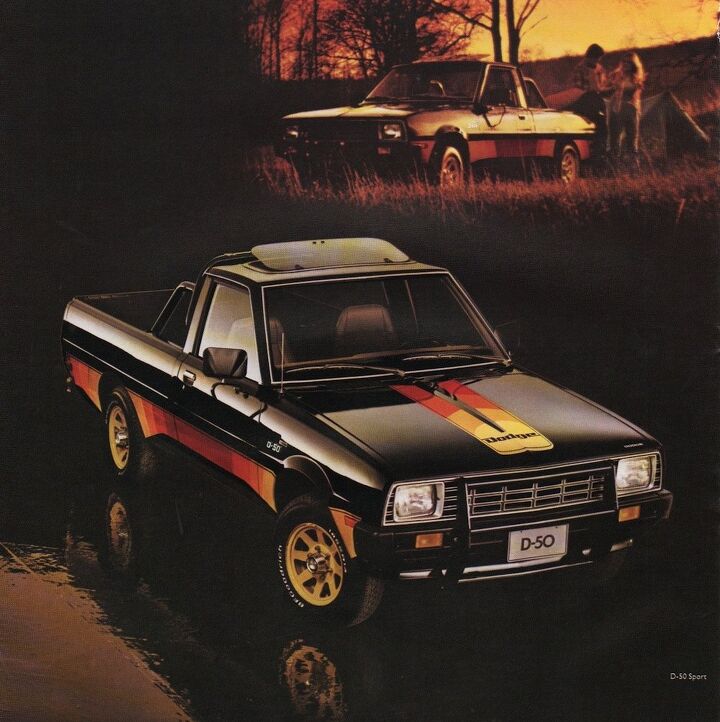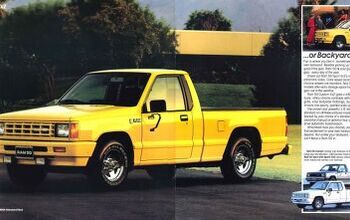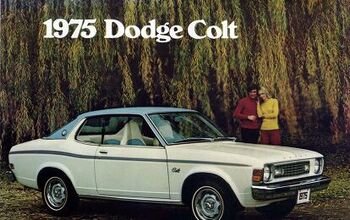Abandoned History: Dodge's Dead Import Trucks (Part I)

Recently on Abandoned History, we learned about the Colt, a captive import Dodge/Plymouth/Eagle/AMC/Renault sold courtesy of a badge swap on some compact cars from Mitsubishi. During that series’ tenure, one of our readers had a great idea: A separate Abandoned History discussion of the captive import trucks and SUVs in the Dodge portfolio. The time has come!
As we discussed previously, the collaboration between Chrysler and Mitsubishi started in 1971 when Chrysler bought a stake in the Japanese conglomerate. Mitsubishi would use Chrysler as an outlet for some of its models in North America, a place where it had no distribution at all. For its investment, Chrysler gained access to small economical vehicles from Japan and didn’t have to spend any dollars on their development. It was a win-win.
The first Colts arrived in North America in 1971, but a truck import was not to follow for some time. The concept of a more efficient compact truck was not one the North American public was ready to accept without some convincing, and it took quite some time. A brief compact truck dissertation is in order.
Datsun was the first to offer its compact truck in the U.S. and started importation in 1959 with the Datsun 1000. Datsun owned the compact truck market for a few years and had the only offering until Toyota joined in 1964 with the Stout. Mazda was the third to market with a B1600 in 1972.
By then, domestic manufacturers noticed the Japanese imports were selling well enough to warrant some competition, and midway through 1972 Chevy began sales of the Isuzu P’up, badged as the LUV. That same year, Ford rebadged a Mazda B and offered the Courier. Both those domestic offerings hit right before the 1973 oil crisis, which saw sales of smaller vehicles (especially Japanese) skyrocket given their efficiency.
Chrysler was left empty-handed. In the mid-Seventies, the Dodge truck lineup consisted of the D series full size, the Ramcharger SUV (also offered as Plymouth Trailduster for a short while), and the Tradesman van series.
Part of the lack of compact truck entry was due to their choice of Japanese partner: Mitsubishi didn’t make a compact truck at all. The company’s largest utility vehicle was the Delica, on offer since 1969. But Delica didn’t translate into a pickup version; the only truck the company sold was a Kei class one. It was called Minicab and was based on the Minica sedan. Mitsubishi was still ramping up and filling in its product lineup throughout the Seventies and early Eighties, becoming the global giant it is today.
The first compact truck Mitsubishi ever made was the Forte. It entered production in 1978 for the Japanese market and went on sale for the ’79 model year. As was standard operating procedure for Mitsubishi, the Forte wore many different names dependent upon market. It was known as the L200 in many places, and that name, in particular, proved a lasting one.
Other market name variations included Mighty Max and various adjectives added to L200 like Express, and Power X. Most examples were built in Japan at Mitsubishi’s Nagoya plant, but there was additional production in Thailand and the Philippines. Mitsubishi’s trucks quickly proved themselves as reliable, affordable work vehicles in many parts of the world.
All examples had two doors, as it was not yet the age of the crew-cab truck. Various engines were used around the globe, but all of them had four cylinders. They ranged from a base 1.6-liter, through two different 2.0-liter mills. The largest gasoline engine was the 2.6, a 4G54 that made its way into many Mitsubishi and Chrysler products through the late Eighties. There were also two diesels, of 2.3- and 2.5-liter persuasions. The smaller one had a turbo. A sign of the times, all transmissions were manual and had either four or five speeds.
Three different wheelbases were offered, which started at 109.4 inches for a short-wheelbase and two-wheel drive. With four-wheel drive, that wheelbase grew to 110 inches. The longest wheelbase was only two-wheel drive and measured 119.5 inches. Overall length was around 184.6 inches, with 65 inches of width, and between 61 and 65 inches overall height dependent upon how many wheels were driven. Four-wheel drive was not available at the outset but was added to Mitsubishi-branded models internationally in 1981.
For size comparison, a D Series full-size truck used various wheelbases of 115, 131, 133, 135, 149, and even 165 inches, with an overall length of between 188 and 240 inches. Overall width was 79.8″, two feet wider than the Mitsubishi. There were many specifications and bed lengths on the full-size Dodge at the time, and it’s difficult to find length specifics. But the size differential was a big one.
Chrysler was quick to get some trucks shipped over to North America, and with an easy badge swap, the new Dodge D-50 was ready for 1979. The new truck also graced Plymouth dealers as the Arrow, not to be confused with the Fire Arrow hatchback (Mitsubishi Lancer). Bearing in mind there weren’t any Mitsubishi dealers in North America at the time, the only way to get one of the trucks was at your friendly Dodge dealer.
The initial styling included single headlamps, a key to telling the age of a first-gen D-50. In other parts of the world, single or double headlamps were available at the buyer’s discretion, alongside double circular headlamps. In Australia, the D-50 was sold as a Chrysler and featured circular headlamps instead.
All D-50s and Arrows were two-wheel-drive through the ’81 model year. Initial trims included the base D-50 with a 2.0-liter engine and a four-speed manual and the D-50 Sport with the 2.6-liter engine and a five-speed manual. Both engines included Mitsubishi’s new Silent Shaft balancing technology. The Sport was the one to have, as it included niceties like a complete gauge package, tape stripes, white letter tires, and even an FM band for the radio.
Exterior additions were few at introduction, and the big ones were a roll bar, grille guard, and a sunroof called “Sky Lite.” The D-50 and Arrow could be fitted with air conditioning, additional tape stripes, black mirrors, power steering, a rear step bumper, and additional sport cladding. Interestingly, unlike the Mitsubishi versions available in the rest of the world, an automatic transmission was available on the D-50. It would’ve been the same three-speed TorqueFlite as offered in the Colt.
Much like the other domestic brands and their captive import compact trucks, Dodge found success with the D-50 and Arrow. Changes for the D-50 happened gradually, the first of which was a renaming after 1980 – to Ram 50. The Plymouth Arrow name was not altered, though it was most certainly a slower seller than its Ram cousin; North American customers were not used to turning to Plymouth for trucks.
Indeed sales of the Arrow were such that it never made it through the first generation’s refresh: Arrow was canceled after the 1982 model year, which left Ram 50 to soak up the remaining customers. That same year, the four-wheel-drive system available since 1981 on the L200 arrived in North America. The drive system warranted special badging, as Power Ram 50. The Power Ram name was the one Dodge historically used to denote four-wheel drive.
In 1983 the Ram 50 was refreshed, visible most easily via the set of four rectangular headlamps. As Mitsubishi established its dealership network in the United States that year, it began selling its truck with its standard badging. For the U.S. market only, the truck was called Mighty Max. One wonders how many would’ve purchased the truck as a Dodge, but chose their Mitsubishi dealer once the option was available. They’d have to like the single headlamp look, as Mitsubishis kept the old appearance while the Dodge got to upgrade to the quad lamps.
Also for 1983, Ram 50 buyers saw a new engine appear as an optional extra: a 2.3-liter turbocharged 4D55 diesel engine. That same year, the same turbodiesel was an option on the new Ford Ranger, too. It was not used in any other North American vehicles. Initial horsepower on the turbodiesel was 80, but that increased in 1984 with a new wastegate to 86 horses. The engine arrived toward the end of the first-generation Ram 50’s run and was available only through 1985.
The first-gen Ram 50 had its final year in 1986, as a new one arrived for 1987. The Ram 50 established itself as a valid compact truck choice for its first-gen run, but Seventies trucks were looking pretty dated by the middle of the next decade. In Part II we’ll cover Ram 50, volume two.
[Images: Chrysler]

Interested in lots of cars and their various historical contexts. Started writing articles for TTAC in late 2016, when my first posts were QOTDs. From there I started a few new series like Rare Rides, Buy/Drive/Burn, Abandoned History, and most recently Rare Rides Icons. Operating from a home base in Cincinnati, Ohio, a relative auto journalist dead zone. Many of my articles are prompted by something I'll see on social media that sparks my interest and causes me to research. Finding articles and information from the early days of the internet and beyond that covers the little details lost to time: trim packages, color and wheel choices, interior fabrics. Beyond those, I'm fascinated by automotive industry experiments, both failures and successes. Lately I've taken an interest in AI, and generating "what if" type images for car models long dead. Reincarnating a modern Toyota Paseo, Lincoln Mark IX, or Isuzu Trooper through a text prompt is fun. Fun to post them on Twitter too, and watch people overreact. To that end, the social media I use most is Twitter, @CoreyLewis86. I also contribute pieces for Forbes Wheels and Forbes Home.
More by Corey Lewis
Latest Car Reviews
Read moreLatest Product Reviews
Read moreRecent Comments
- Carson D Just don't be the whistleblower who reports on the falsification of safety data. That's a deadly profession.
- Carson D I'd have responded sooner, but my computer locked up and I had to reboot it.
- Todd In Canada Mazda has a 3 year bumper to bumper & 5 year unlimited mileage drivetrain warranty. Mazdas are a DIY dream of high school auto mechanics 101 easy to work on reliable simplicity. IMO the Mazda is way better looking.
- Tane94 Blue Mini, love Minis because it's total custom ordering and the S has the BMW turbo engine.
- AZFelix What could possibly go wrong with putting your life in the robotic hands of precision crafted and expertly programmed machinery?







































Comments
Join the conversation
And out come the rose colored glasses. These were slow and crude and lacked the power to pull a greasy string out of a cat's kiester, but at least they were unsafe too!
Real trucks have very short beds mounted very high in the air, to avoid any grime associated with doing actual useful work. (I know this because there is a Ford dealer two miles from my house.)